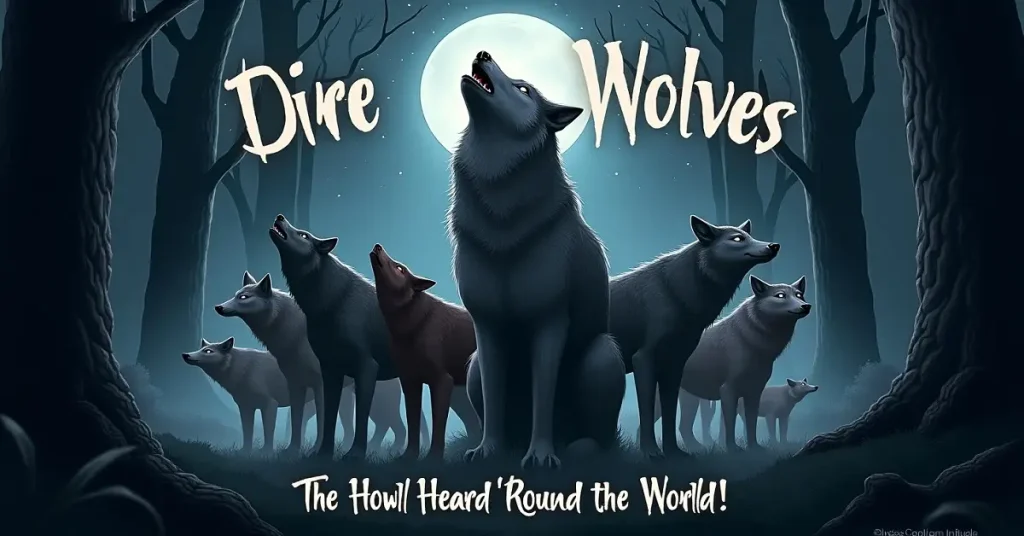In a twist straight out of a sci-fi blockbuster, Dallas-based biotech firm Colossal Biosciences has dropped a bombshell that’s got the world buzzing: dire wolves—those legendary beasts of Ice Age lore and Game of Thrones fame—are back! Or are they?
On October 1, 2024, two strapping pups named Romulus and Remus were born, followed by a third, Khaleesi, in January 2025. Using ancient DNA scraped from fossils as old as 72,000 years and cutting-edge CRISPR gene-editing wizardry, Colossal claims to have resurrected a species extinct for over 12,000 years.
But hold your howls—scientists and skeptics alike are snarling over whether these furry newcomers are the real deal or just souped-up grey wolves in dire wolf clothing.
Dire Wolves Return
The saga begins with Colossal’s audacious mission to “de-extinct” lost species. Armed with DNA from a 13,000-year-old tooth and a 72,000-year-old skull, their team tweaked the genes of modern grey wolves—dire wolves’ closest living kin, sharing 99.5% of their DNA—to recreate traits like massive jaws, thick white fur, and a linebacker-worthy build.
The result? Romulus and Remus, already tipping the scales at 80 pounds at six months, are on track to hit 140 pounds—20-25% bigger than your average grey wolf. Khaleesi, the younger female, is hot on their heels. Housed in a secretive 2,000-acre preserve behind 10-foot zoo-grade fencing, these pups are living the high life under constant surveillance, with drones and cameras tracking their every growl.
Read More: Bagram Bombshell: Is the U.S. Plotting a Secret Strike on Iran from Afghanistan?
Colossal’s CEO, Ben Lamm, isn’t shy about the hype, calling it “a massive milestone” and likening their tech to “magic.” “Our team took ancient DNA and made healthy dire wolf puppies,” he boasted in a statement that’s gone viral. Social media erupted, with X posts marveling at the pups’ haunting howls—billed as the first dire wolf cries in millennia.
TIME magazine slapped Romulus on its cover, dubbing it a “scientific wonder,” while Bloomberg and The New York Times scrambled to report the scoop. Even Game of Thrones creator George R.R. Martin, an investor in Colossal, chimed in: “I write about magic, but Ben and Colossal have created it.”
But not everyone’s howling with joy. Critics are baring their teeth, questioning if this is true de-extinction or a genetic Frankenstein experiment. “All you can do is make something look superficially like something else,” warned Vincent Lynch, a biologist at the University at Buffalo, pointing out that the pups are built on a grey wolf base with just 20 edits across 14 genes.
That’s a far cry from the millions of DNA differences between grey wolves and their extinct cousins. Colossal’s own Beth Shapiro admits they’re not exact clones but “genetic facsimiles” designed to mimic dire wolf traits. “If they look like dire wolves, they are dire wolves,” she told New Scientist—a claim that’s sparked fierce debate.
The ethical stakes are as high as the preserve’s fences. Some see this as a conservation breakthrough, especially since Colossal also cloned endangered red wolves using the same tech.
Others draw chilling Jurassic Park parallels, with X users joking, “No possible way this could go wrong, right?” The pups won’t roam free—lacking wild dire wolf parents, they’ll never learn to hunt megafauna like their ancestors did. Instead, they’re destined for a cushy life in captivity, leaving experts like Lynch to argue they can’t restore the ecological roles dire wolves once played.
So, are Romulus, Remus, and Khaleesi the triumphant return of a lost legend, or a high-tech mirage? The science is real—CRISPR, ancient DNA, and surrogate dog moms made this happen—but the fiction might lie in the label. As the world watches these wolves grow, one thing’s clear: Colossal has unleashed a debate as fierce as any dire wolf pack. Will this be a howling success or a cautionary tale? Stay tuned—the Ice Age just got a lot hotter!
Read More:
- Tariff Turmoil Unleashes Global Market Chaos: Is This the Crash We’ve All Feared?
- Orange Monday Meltdown: Trump’s Tariffs Trigger Global Market Chaos – Is Your Wallet Next?
- How to Protect Yourself Against CloudFlare Hackers? [2025]
- Peacemaker Season 2 Premiere Date Unveiled: John Cena’s Explosive Return Will Leave You Speechless!
- Second Child Dies in Texas Measles Outbreak as RFK Jr. Finally Admits Vaccine Works
- Kaka Shocks the World: ‘Ronaldo Is the GOAT, Not Messi!’
- Bitcoin on the Brink: Will It Crash to $60K or Soar Back to $100K? The Crypto World Holds Its Breath!
- Meta’s Llama 4 Unveiled: Scout, Maverick, and Behemoth Set to Crush ChatGPT and Redefine AI—You Won’t Believe Their Power!
- Everton Hands Liverpool the Premier League Crown: You Won’t Believe How!
- Trump and Musk Under Fire: ‘Hands Off!’ Protests Explode Across America in a Day of Defiance!
- Kawasaki’s CORLEO Unveiled: Is This Hydrogen-Powered Robotic Horse the Future of Travel or Just Sci-Fi Hype?

